Page 1
Page 2 Page
3
Page 4 Page
5
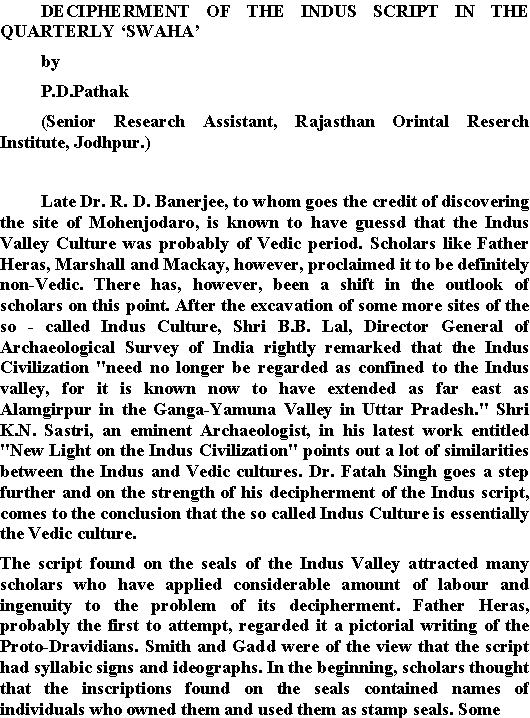
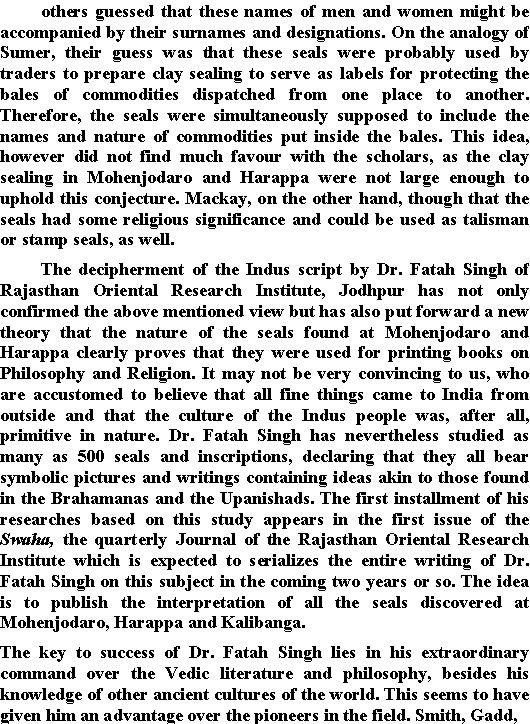
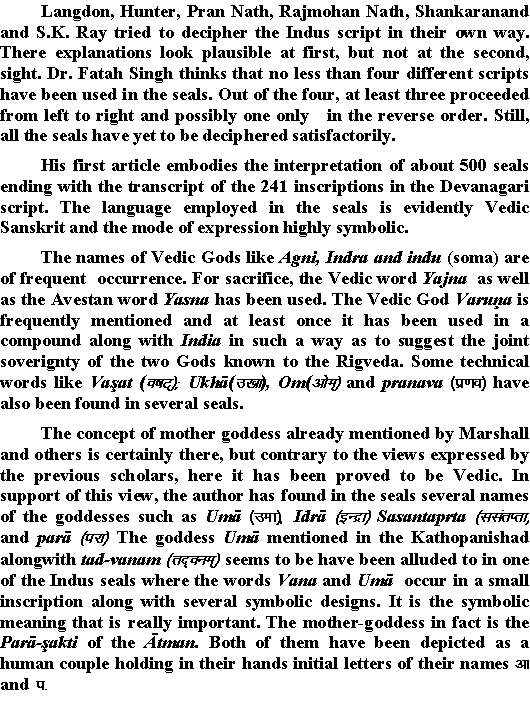
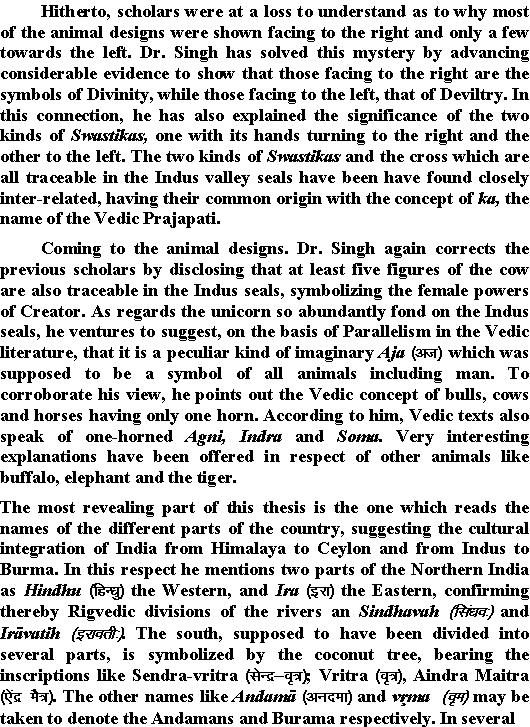
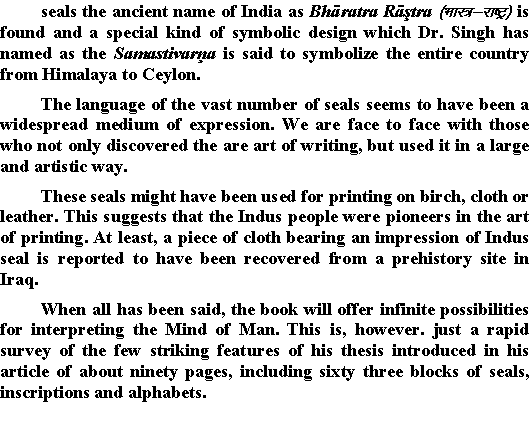
Page 1
Page 2 Page
3
Page 4 Page
5
DECIPHERMENT
OF THE
INDUS
SCRIPT IN THE QUARTERLY ‘SWAHA’
by
P.D.Pathak
(Senior Research Assistant,
Rajasthan Orintal Reserch Institute,
Jodhpur
.)
Late Dr. R. D. Banerjee, to
whom goes the credit of discovering the site of Mohenjodaro, is known to have
guessd that the Indus Valley Culture was probably of Vedic period. Scholars like
Father Heras,
Marshall
and Mackay, however, proclaimed it to be definitely non-Vedic. There has,
however, been a shift in the outlook of scholars on this point. After the
excavation of some more sites of the so - called Indus Culture, Shri B.B. Lal,
Director General of Archaeological Survey of India rightly remarked that the
Indus Civilization "need no longer be regarded as confined to the Indus
valley, for it is known now to have extended as far east as Alamgirpur in the
Ganga-Yamuna Valley in Uttar Pradesh." Shri K.N. Sastri, an eminent
Archaeologist, in his latest work entitled "New Light on the Indus
Civilization" points out a lot of similarities between the
Indus
and Vedic cultures. Dr. Fatah Singh goes a step further and on the strength of
his decipherment of the
Indus
script, comes to the conclusion that the so called Indus Culture is essentially
the Vedic culture.
The script found on the seals
of the
Indus
Valley
attracted many scholars who have applied considerable amount of labour and
ingenuity to the problem of its decipherment. Father Heras, probably the first
to attempt, regarded it a pictorial writing of the Proto-Dravidians. Smith and
Gadd were of the view that the script had syllabic signs and ideographs. In the
beginning, scholars thought that the inscriptions found on the seals contained
names of individuals who owned them and used them as stamp seals. Some others
guessed that these names of men and women might be accompanied by their surnames
and designations. On the analogy of
Sumer
, their guess was that these seals were probably used by traders to prepare clay
sealing to serve as labels for protecting the bales of commodities dispatched
from one place to another. Therefore, the seals were simultaneously supposed to
include the names and nature of commodities put inside the bales. This idea,
however did not find much favour with the scholars, as the clay sealing in
Mohenjodaro and
Harappa
were not large enough to uphold this conjecture. Mackay, on the other hand,
though that the seals had some religious significance and could be used as
talisman or stamp seals, as well.
The decipherment of the
Indus
script by Dr. Fatah Singh of Rajasthan Oriental Research Institute, Jodhpur has
not only confirmed the above mentioned view but has also put forward a new
theory that the nature of the seals found at Mohenjodaro and Harappa clearly
proves that they were used for printing books on Philosophy and Religion. It may
not be very convincing to us, who are accustomed to believe that all fine things
came to
India
from outside and that the culture of the
Indus
people was, after all, primitive in nature. Dr. Fatah Singh has nevertheless
studied as many as 500 seals and inscriptions, declaring that they all bear
symbolic pictures and writings containing ideas akin to those found in the
Brahamanas and the Upanishads. The first installment of his researches based on
this study appears in the first issue of the Swaha, the quarterly Journal of the Rajasthan Oriental Research
Institute which is expected to serializes the entire writing of Dr. Fatah Singh
on this subject in the coming two years or so. The idea is to publish the
interpretation of all the seals discovered at Mohenjodaro,
Harappa
and Kalibanga.
The key to success of Dr.
Fatah Singh lies in his extraordinary command over the Vedic literature and
philosophy, besides his knowledge of other ancient cultures of the world. This
seems to have given him an advantage over the pioneers in the field. Smith,
Gadd, Langdon, Hunter, Pran Nath, Rajmohan Nath, Shankaranand and S.K. Ray tried
to decipher the
Indus
script in their own way. There explanations look plausible at first, but not at
the second, sight. Dr. Fatah Singh thinks that no less than four different
scripts have been used in the seals. Out of the four, at least three proceeded
from left to right and possibly one only
in the reverse order. Still, all the seals have yet to be deciphered
satisfactorily.
His first article embodies
the interpretation of about 500 seals ending with the transcript of the 241
inscriptions in the Devanagari script. The language employed in the seals is
evidently Vedic Sanskrit and the mode of expression highly symbolic.
The names of Vedic Gods like Agni,
Indra and indu (soma) are of frequent occurrence.
For sacrifice, the Vedic word Yajna
as well as the Avestan word Yasna
has been used. The Vedic God Varuņa
is frequently mentioned and at least once it has been used in a compound
along with
India
in such a way as to suggest the joint
soverignty of the two Gods known to the Rigveda. Some technical words like Vaşat
(o"kV~½(
Ukhā(m[kk),
Om
(vkse~½ and
pranava ¼iz.ko½
have also been found in several seals.
The concept of mother goddess
already mentioned by Marshall and others is certainly there, but contrary to the
views expressed by the previous scholars, here it has been proved to be Vedic.
In support of this view, the author has found in the seals several names of the
goddesses such as Umā ¼mek½] Idrā
¼bUnzk½
Sasantaprta ¼llarIrk½ and
parā ¼ijk½ The goddess Umā mentioned
in the Kathopanishad alongwith tad-vanam ¼rn~oue~½
seems to be have been
alluded to in one of the Indus seals where the words Vana and Umā occur
in a small inscription along with several symbolic designs. It is the symbolic
meaning that is really important. The mother-goddess in fact is the Parā-şakti
of the Ātman. Both of them have
been depicted as a human couple holding in their hands initial letters of their
names vk
and i-
Hitherto, scholars were at a
loss to understand as to why most of the animal designs were shown facing to the
right and only a few towards the left. Dr. Singh has solved this mystery by
advancing considerable evidence to show that those facing to the right are the
symbols of Divinity, while those facing to the left, that of Deviltry. In this
connection, he has also explained the significance of the two kinds of Swastikas,
one with its hands turning to the right and the other to the left. The two
kinds of Swastikas and the cross which are all traceable in the
Indus
valley seals have been have found closely inter-related, having their common
origin with the concept of ka, the
name of the Vedic Prajapati.
Coming to the animal designs.
Dr. Singh again corrects the previous scholars by disclosing that at least five
figures of the cow are also traceable in the
Indus
seals, symbolizing the female powers of Creator. As regards the unicorn so
abundantly fond on the
Indus
seals, he ventures to suggest, on the basis of Parallelism in the Vedic
literature, that it is a peculiar kind of imaginary Aja
¼vt½
which was supposed to be a
symbol of all animals including man. To corroborate his view, he points out the
Vedic concept of bulls, cows and horses having only one horn. According to him,
Vedic texts also speak of one-horned Agni,
Indra and Soma. Very interesting
explanations have been offered in respect of other animals like buffalo,
elephant and the tiger.
The most revealing part of
this thesis is the one which reads the names of the different parts of the
country, suggesting the cultural integration of
India
from Himalaya to
Ceylon
and from Indus to
Burma
. In this respect he mentions two parts of the
Northern India
as Hindhu ¼fgU/kq½
the Western, and Ira ¼bjk½
the Eastern, confirming thereby Rigvedic divisions of the rivers an Sindhavah
¼fla/ko%½
and Irāvatih
¼bjkorh%½.
The south, supposed to
have been divided into several parts, is symbolized by the coconut tree, bearing
the inscriptions like Sendra-vritra ¼lsUnz&o`=½; Vritra ¼o`=½,
Aindra Maitra ¼,sanz eS=½. The
other names like Andamā ¼vunek½
and vŗma
¼o`e½
may be taken to denote the
Andamans and Burama respectively. In several seals the ancient name of India as Bhāratra
Rāştra ¼Hkkj=&jk"Vª½ is found and a special kind of symbolic design which Dr. Singh has
named as the Samastivarņa is said
to symbolize the entire country from Himalaya to Ceylon.
The language of the vast
number of seals seems to have been a widespread medium of expression. We are
face to face with those who not only discovered the are art of writing, but used
it in a large and artistic way.
These seals might have been
used for printing on birch, cloth or leather. This suggests that the
Indus
people were pioneers in the art of printing. At least, a piece of cloth bearing
an impression of Indus seal is reported to have been recovered from a prehistory
site in
Iraq
.
When all has been said, the
book will offer infinite possibilities for interpreting the Mind of Man. This
is, however. just a rapid survey of the few striking features of his thesis
introduced in his article of about ninety pages, including sixty three blocks of
seals, inscriptions and alphabets.